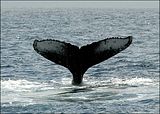Friday’s news and open thread…
-
The Los Angeles Times reports Court rejects EPA’s scheme to allow excessive mercury emissions. “A federal appeals court today struck down a market-based effort by the Bush administration to regulate emissions of mercury from coal- and oil-fired power plants, agreeing with critics that the Environmental Protection Agency had violated the Clean Air Act when it established the rule… The EPA had planned to establish a mandatory national cap on mercury emissions and then allow power plants that fail to meet their targets to buy credits from less-polluting plants. Environmentalists have criticized this approach because mercury tends to accumulate near its source, rather than dispersing like other pollutants that have been regulated under so-called cap-and-trade mechanisms.”
-
Via TPMmuckraker, the Wall Street Journal reports Contractors likely involved in waterboarding. “The CIA’s secret interrogation program has made extensive use of outside contractors, whose role likely included the waterboarding of terrorist suspects, according to testimony yesterday from the CIA director and two other people familiar with the program. Many of the contractors involved aren’t large corporate entities but rather individuals who are often former agency or military officers. However, large corporations also are involved, current and former officials said. Their identities couldn’t be learned… Using nongovernment employees also helped maintain a low profile, they said.” Is your next door neighbor a freelance mercenary torturer for the CIA?
-
Reuters reports Nebraska Supreme Court rules electric chair unconstitutional.
The Nebraska Supreme Court struck down the state’s reliance on the electric chair for executions on Friday as “cruel and unusual” punishment, leaving no alternative method in its place.
“We recognize the temptation to make the prisoner suffer, just as the prisoner made an innocent victim suffer,” the court wrote. “But it is the hallmark of a civilized society that we punish cruelty without practicing it.”
In its 6-1 ruling, the court said evidence proves that unconsciousness and death are not instantaneous for many prisoners and they could experience intense pain and “agonizing suffering.”
Nebraska is the only U.S. state that uses the electric chair as its only means of execution, though a few others still allow prisoners to choose it as an alternative to lethal injection.
Governor Dave Heineman is “appalled” by ruling. “‘I am appalled by (the court’s) decision,’ the governor said in a statement. ‘…the court has asserted itself improperly as a policymaker. Once again, this activist court has ignored its own precedent and the precedent set by the U.S. Supreme Court to continue its assault on the Nebraska death penalty.'” The Nebraska Republican has a self-described “pro-life administration“.
-
 A mysterious shipwreck has been revealed by winter storms in Oregon. The Oregonian has the story, A ship in the sands of time. “A massive wooden ship that disappeared on the southern Oregon coast decades and decades ago is emerging from a sand dune eroded by wild winter storms. On a remote beach of Coos Bay’s North Spit, the seas are revealing the bow of a mystery ship. Thirty feet of its thick, wooden bow protrudes from the dune. Forty feet wide at its broadest point, the hull sits dug into the dune, pointed toward the sea. Its iron supports are rusted and bent, its deck supports exposed, its portholes deep and square. The ship was built from massive timbers and likely dates to the late 19th or early 20th century… Between 1852 and 1953, 58 ships wrecked in a span of about five miles off Coos Bay”.
A mysterious shipwreck has been revealed by winter storms in Oregon. The Oregonian has the story, A ship in the sands of time. “A massive wooden ship that disappeared on the southern Oregon coast decades and decades ago is emerging from a sand dune eroded by wild winter storms. On a remote beach of Coos Bay’s North Spit, the seas are revealing the bow of a mystery ship. Thirty feet of its thick, wooden bow protrudes from the dune. Forty feet wide at its broadest point, the hull sits dug into the dune, pointed toward the sea. Its iron supports are rusted and bent, its deck supports exposed, its portholes deep and square. The ship was built from massive timbers and likely dates to the late 19th or early 20th century… Between 1852 and 1953, 58 ships wrecked in a span of about five miles off Coos Bay”.
A bonus story about the Enchantress is below the fold…

 The Guardian reports
The Guardian reports  Another
Another 
 Meanwhile, ridership has risen so much that transit authorities are having trouble keeping up with demand… The high cost of gas and parking are helping wrench a vast army of suburbanites from behind their steering wheels — so much so that riders complain they often have to stand, and transit officials are warning that they are bumping up against capacity… Although the big jump in riders coincides with the big jump in gas prices over the past couple of years, a surprising number of suburban transit users say that heightened concern about emissions and climate change also play a role.” Here’s a link to
Meanwhile, ridership has risen so much that transit authorities are having trouble keeping up with demand… The high cost of gas and parking are helping wrench a vast army of suburbanites from behind their steering wheels — so much so that riders complain they often have to stand, and transit officials are warning that they are bumping up against capacity… Although the big jump in riders coincides with the big jump in gas prices over the past couple of years, a surprising number of suburban transit users say that heightened concern about emissions and climate change also play a role.” Here’s a link to  The Los Angeles Times reports
The Los Angeles Times reports  The Washington Post reports
The Washington Post reports  The Los Angeles Times report on
The Los Angeles Times report on  Bloomberg News reports
Bloomberg News reports  the proposed freeze would go into effect in July, when troops levels reach around 130,000. Although violence is dropping in Iraq, commanders say they want to halt withdrawals to assess whether they can control the situation with fewer troops… Officers are still debating the length of the proposed freeze, with some arguing for 90 days and others saying it could be as short as 30. Because it can take as long as 75 days to withdraw a brigade, a freeze could result in troop levels remaining steady through most of the rest of Bush’s term, deferring any continued drawdown to his successor. Military planners fear that maintaining the current pace of withdrawals could lead to an unstable situation just as a new administration takes office in January.” Bush’s ‘temporary surge’ now becomes permanent. Surprised?
the proposed freeze would go into effect in July, when troops levels reach around 130,000. Although violence is dropping in Iraq, commanders say they want to halt withdrawals to assess whether they can control the situation with fewer troops… Officers are still debating the length of the proposed freeze, with some arguing for 90 days and others saying it could be as short as 30. Because it can take as long as 75 days to withdraw a brigade, a freeze could result in troop levels remaining steady through most of the rest of Bush’s term, deferring any continued drawdown to his successor. Military planners fear that maintaining the current pace of withdrawals could lead to an unstable situation just as a new administration takes office in January.” Bush’s ‘temporary surge’ now becomes permanent. Surprised? As Americans increasingly link their well-being to financial markets, the possibility of recession and a slump on Wall Street has taken on new meaning for the middle class, including baby boomers who are approaching retirement age.
As Americans increasingly link their well-being to financial markets, the possibility of recession and a slump on Wall Street has taken on new meaning for the middle class, including baby boomers who are approaching retirement age.  The Independent reports on the discovery that a
The Independent reports on the discovery that a  Another shocker story from the Los Angeles Times,
Another shocker story from the Los Angeles Times,  Time magazine notes that today,
Time magazine notes that today,  The Guardian reports that bad news that
The Guardian reports that bad news that  According to Spiegel, there is
According to Spiegel, there is 